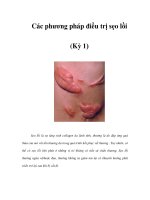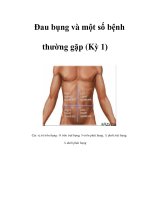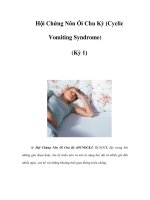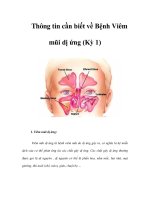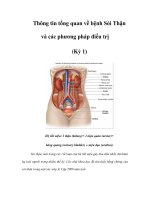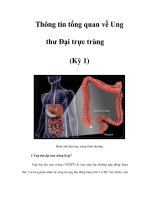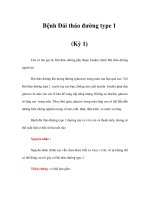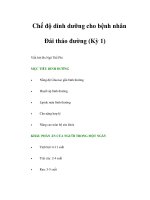Non-Allergic Rhinitis (Kỳ 1) pot
Bạn đang xem bản rút gọn của tài liệu. Xem và tải ngay bản đầy đủ của tài liệu tại đây (69.12 KB, 6 trang )
Non-Allergic Rhinitis
(Kỳ 1)
"This material was prepared by resident physicians in partial fulfillment of
educational requirements established for the Postgraduate Training Program of
the UTMB Department of Otolaryngology/Head and Neck Surgery and was not
intended for clinical use in its present form. It was prepared for the purpose of
stimulating group discussion in a conference setting. No warranties, either express
or implied, are made with respect to its accuracy, completeness, or timeliness. The
material does not necessarily reflect the current or past opinions of members of
the UTMB faculty and should not be used for purposes of diagnosis or treatment
without consulting appropriate literature sources and informed professional
opinion."
Introduction
Rhinitis in general is defined as two or more nasal symptoms of: nasal
congestion, rhinorrhea, sneezing or impairment of smell for more than 1 hr a day.
There are different forms of rhinitis, generally divided into three main categories
1) Infectious rhinitis 2) Allergic rhinitis 3) Non-Allergic rhinitis. Allergic rhinitis
is defined as immunologic nasal response, primary mediated by immunoglobulin
E (IgE).
Non-allergic rhinitis is defined as rhinitis symptoms in the absence of
identifiable allergy, structure abnormality or sinus disease. There have been many
terms to describe non-allergic rhinitis which include vasomotor rhinitis, vascular
rhinitis, perennial, chronic and noninfectious perennial rhinitis, among others.
A quick review of nasal function is warranted. Nasal function includes
temperature regulation, olfaction, humidification, filtration and protection. The
nasal mucosal lining contains IgA, proteins and enzymes which help protect from
infections. Also, nasal cilia propel the matter toward the natural ostia at a
frequency of 10-15 beats per minute, which causes a mucous flow at rate of 2.5 to
7.5 ml per minute.
A review of the epidemiology shows that up to 10% of the US population is
affected by rhinitis. That is 58 million Americans with allergic rhinitis and
another 19 million with non-allergic rhinitis. However, in the population that
present to an ENT clinic, 50% of rhinitis patients are diagnosed with allergic
rhinitis and the other 50% are diagnosed with non-allergic rhinitis.
Potential problems that arise from non-allergic rhinitis (NAR) are similar to
allergic rhinitis, which include development of sinusitis, Eustachian tube
dysfunction, chronic otitis media and anosmia. This leads to decreased work
productivity and frequent doctor visits. Also, the treatment leads to side effects of
drowsiness, epistaxis and nasal dryness.
CAUSES
In this talk, we will discuss the major causes of non-allergic rhinitis. They
are broken down into the following:
Occupational, Drug induced, Rhinitis Medicatmentosa, NARES,
Hormonal, Idiopathic or Vasomotor and Mimicker.
Occupational
Arises from airborne agents at a patient’s workplace. These agents do not
act through immune mediated systems, but are an irritant to the nasal mucosa and
cause hyper responsive reactions. They trigger both the Olfactory nerve and the
Trigeminal nerve that senses burning and irritation by airborne chemicals.
There have been over 205 different chemical identified as irritants. They
include cigarette smoke, solvents like chlorine, metal salts, latex, glues and wood
dust. These patients usually present with a concurrent occupational asthma.
For diagnosis, we use primarily history and nasal provocation with stimuli.
About 70% of patients improve with symptoms when triggers are avoided.
Drug Induced Rhinitis
There are a variety of medications that can cause rhinitis when administered
either orally or topically. These drugs can be divided into two main groups as
pharmacologic or aspiring hypersensitivity.
Here is that include many of the drugs that are common causes rhinitis.
· Cocaine
· Topical nasal decongestants
· phosphodiesterase type-5 inhibitors (PDE-5) Sildenafi
· Alpha-adrenoceptor antagonists
· Reserpine
· Hydralazine
· Angiotensin-converting enzyme inhibitors
· Beta-blockers
· Methyldopa
· Guanethidine
· Phentolamine
· Oral contraceptives
· Non steroidal anti-inflammatory medications
· Aspirin
· Psychotropic agents
· Thioridazine
· Chlordiazepoxide
· Chlorpromazine
· Amitriptyline
· Perphenazine
· Alprazolam
Many common antihypertensive medication and psychiatric medications
cause rhinitis. These are infrequent but predicable side effects. They usually lead
to congestion, but PND and watery secretions can be other symptoms.
PDE-5 inhibitors like Sildenafil (Viagra) cause allergic rhinitis by inducing
engorgement of the nasal mucosa including the turbinates.
Intolerance to ASA or NSAIDS is unpredictable. However, they
predominately cause rhinorrhea. ASA rhinitis may be a part of the ASA triad of
hyperplasic rhinosinusitis, nasal polyps and asthma.
